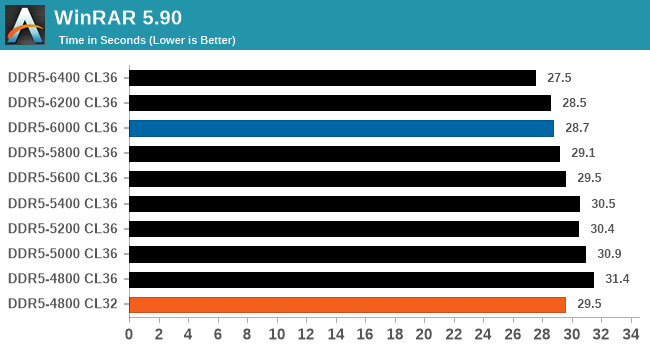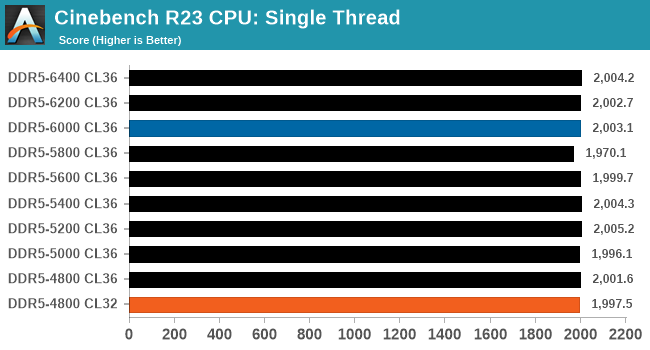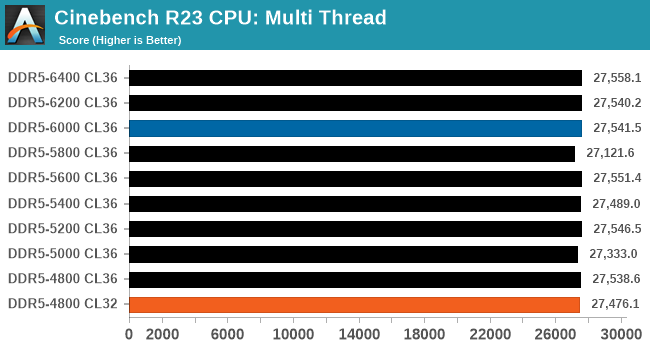Intel Alder Lake DDR5 Memory Scaling Analysis With G.Skill Trident Z5
by Gavin Bonshor on December 23, 2021 9:00 AM ESTCPU Performance, Short Form
To show the performance and scaling of DDR5 memory, we've opted for a more selective and short-form selection of benchmarks from our test suite.
Compression – WinRAR 5.90: link
Our WinRAR test from 2013 is updated to the latest version of WinRAR at the start of 2014. We compress a set of 2867 files across 320 folders totaling 1.52 GB in size – 95% of these files are small typical website files, and the rest (90% of the size) are small 30-second 720p videos.

Blue is XMP; Orange is JEDEC at Low CL
In our WinRAR 5.90 benchmark, this is where we saw the most effective and conclusive levels of performance, From DDR5-4800 CL36 to DDR5-6400 CL36, we saw an impressive 14.1 % increase in throughput. Even at the DDR5-6000 CL36 XMP, there was a 9.4% jump in performance in terms of scale from the baseline.
The DDR5-4800 CL32 also provided a good uplift in performance here. It should also be noted that WinRAR 5.90 performance can be very memory dependant, and it shows in our results.
Rendering - Blender 2.79b: 3D Creation Suite
A high-profile rendering tool, Blender is open-source allowing for massive amounts of configurability, and is used by a number of high-profile animation studios worldwide. The organization recently released a Blender benchmark package, a couple of weeks after we had narrowed our Blender test for our new suite, however their test can take over an hour. For our results, we run one of the sub-tests in that suite through the command line - a standard ‘bmw27’ scene in CPU only mode, and measure the time to complete the render.

Blue is XMP; Orange is JEDEC at Low CL
In terms of scaling performance in our Blender benchmark, we saw very little variation in performance from top to bottom. Although the Trident Z5 at DDR5-6400 CL36 did perform best, it was a modest 0.6% jump in performance from our lowest result to the best.
Rendering - Cinebench R23: link
Maxon's real-world and cross-platform Cinebench test suite has been a staple in benchmarking and rendering performance for many years. Its latest installment is the R23 version, which is based on its latest 23 code which uses updated compilers. It acts as a real-world system benchmark that incorporates common tasks and rendering workloads as opposed to less diverse benchmarks which only take measurements based on certain CPU functions. Cinebench R23 can also measure both single-threaded and multi-threaded performance.


Blue is XMP; Orange is JEDEC at Low CL
Looking at performance in Cinebench R23, the results were a little sporadic, in both the single-threaded and multi-threaded testing. All of the results in the single-threaded test were within a margin of 1.8%, with the multi-threaded results within a 1.6% level of variation from top to bottom.
3DPMv2.1 – 3D Movement Algorithm Test: link
3DPM is a self-penned benchmark, taking basic 3D movement algorithms used in Brownian Motion simulations and testing them for speed. High floating point performance, MHz, and IPC win in the single thread version, whereas the multithread version has to handle the threads and loves more cores. For a brief explanation of the platform agnostic coding behind this benchmark, see my forum post here.

Blue is XMP; Orange is JEDEC at Low CL
Similar to what we saw in both Cinebench R23 and in our Blender benchmarks, performance in our 3DPM v2.1 testing shows little to no improvement with faster memory across the range of results. The level of variation between the best result and the worst result was around 0.3%.










82 Comments
View All Comments
Spunjji - Friday, December 24, 2021 - link
Not worth it yet, then. Go go DDR4!mirancar - Friday, December 24, 2021 - link
hello guyscan we also test some web browser (javascript) performance? i think most people either running games or using the web browser all the time. (sadly) even alot of applications are now made with web browser engine
also the SPEC int/fp suite bench could be useful or even just geekbench 5
the gaming benchmarks also seem abit flawed, the way it was tested with the gtx 1080, would it even make a difference even if using some older hardware ? i think it would be better finding games which have a cpu bottleneck and scale well with actual differenc cpus used. can you have same performance for example with 12700k+ddr5 6000 vs 12900k+ddr5 4800 ?
Oxford Guy - Friday, December 24, 2021 - link
‘What's very interesting from our testing is when we went low latency at DDR5-4800 with CL32 latencies. Tightening up the primary latencies at the same frequency netted us an additional 6.4% jump in performance, which shows there that increasing frequency isn't the only way to improve overall performance.’So that DDR-5 7000 mentioned may not be ‘extremely fast’ in the real world.
The lack of DDR-4 with low latencies at various speeds here seems to be an oversight, in terms of providing necessary context. Consider a follow-up that includes the DDR-4 data.
ruthan - Friday, December 24, 2021 - link
Nice but without DDR4 and price / performance ration is not great.Tchamber - Saturday, December 25, 2021 - link
I remember when they used to make low-latency chips. My first DDR3 was for an i7 920, and I had some super, super low latency memory that was expensive, but at least it was an option. It would be nice to see them make that available.TheinsanegamerN - Monday, January 3, 2022 - link
It is available. DDR4 4000 CL 15 memory is a thing.Silver5urfer - Saturday, December 25, 2021 - link
Skip the entire ADL tbh. If you are running X470, Z390 and up. There's no need to upgrade to this experimental platform. You pay more for single digit gains. Not worth. Skip this and Zen 4, get Zen 5 and then Intel. By that time PCIe5.0 and DDR5 will have 2 years of maturity.Wereweeb - Sunday, December 26, 2021 - link
A comment by Silver5urfer that is actually reasonable, thank you for this christmas gift.Kvaern1 - Tuesday, December 28, 2021 - link
This just confirms what has always been true.Expensive highend RAM has no noticeable effect on most usecases.
Oxford Guy - Tuesday, December 28, 2021 - link
That depends. If one is comparing JEDEC 2133 CL15 DDR4 with B-die running at 3200 CL14 on Zen there is a big performance difference in games. For example, take a look at the reddit topic 'I compared 3200Mhz ram vs 2133 in 12 games'.Going after MHz sees diminishing returns set in quickly after a certain point. With Zen 3, the optimum MHz is 3600. With Zen 2 it's probably 3200 with that low command rate of 14. Zen 1 also paid dividends via running 3200 RAM instead of slower RAM.